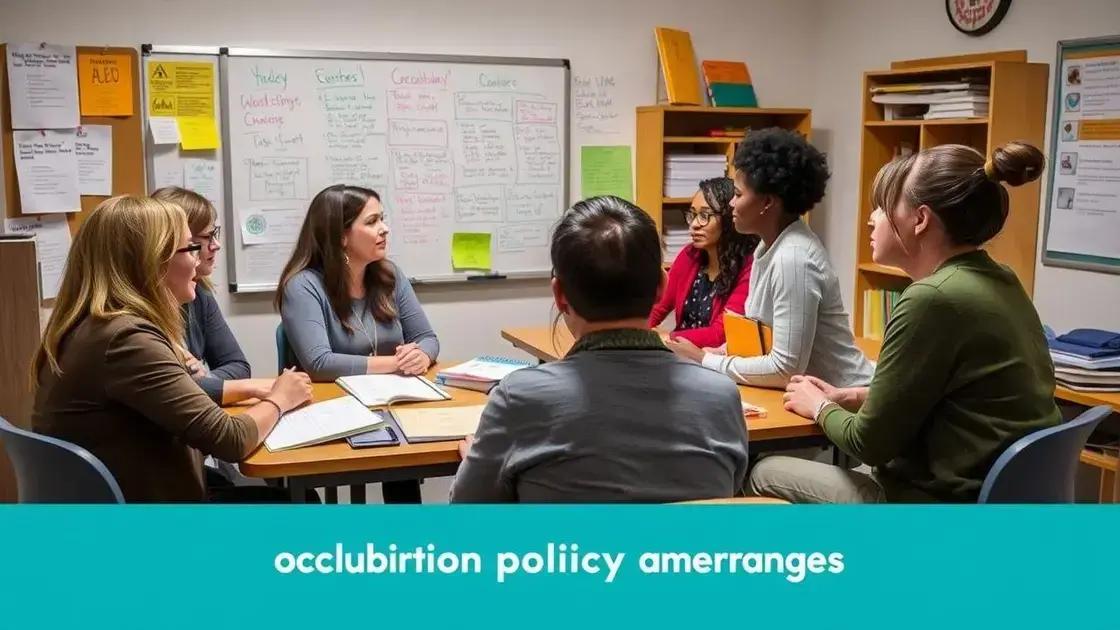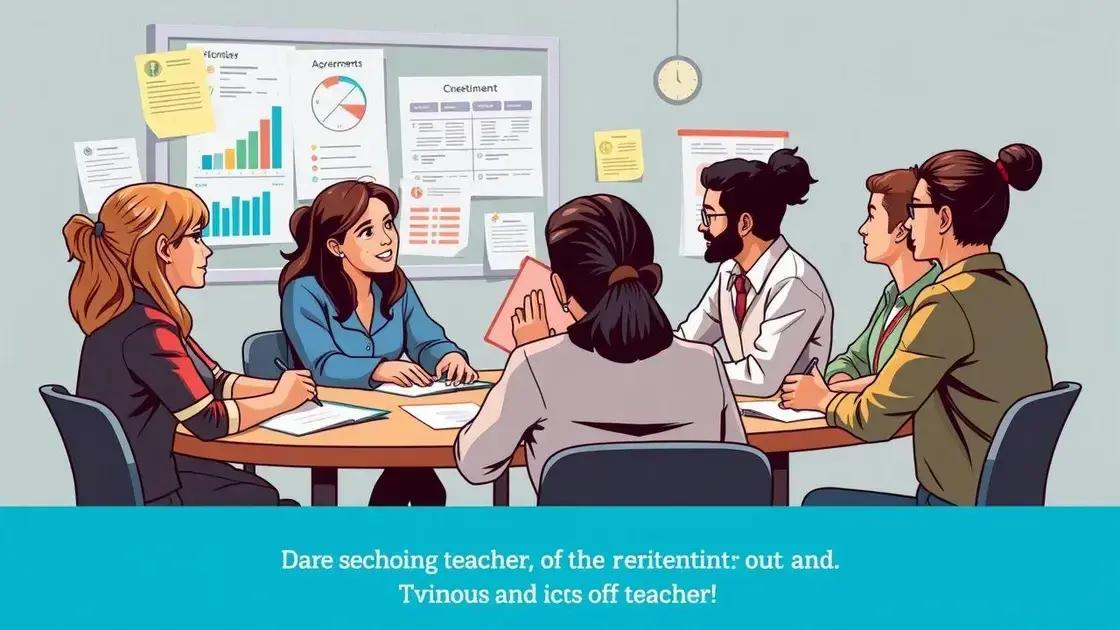Teacher union responses: understanding their impact

Teacher unions advocate for educators by negotiating contracts and influencing education policies, while facing challenges like political opposition and funding constraints, shaping the future of education through adaptation and community engagement.
Teacher union responses have become increasingly significant in today’s educational landscape. But what exactly do they entail? In this article, we delve into how these unions influence policies and support educators, inviting you to explore their vital role.
Understanding teacher unions
Understanding teacher unions is essential for grasping their role in shaping educational policies. These organizations represent the interests of educators, advocating for better working conditions, salaries, and student resources. By uniting teachers, unions empower them to stand up for their rights and push for necessary changes.
What are teacher unions?
Teacher unions are groups formed by educators to collectively negotiate with school administrations and government bodies. Their strength lies in their ability to represent the collective voice of teachers, ensuring that their concerns are heard.
Key functions of teacher unions
- Negotiation: Unions negotiate contracts on behalf of their members, focusing on pay and benefits.
- Advocacy: They advocate for policies that benefit education and improve the teaching profession.
- Support: Teacher unions provide legal support and guidance to their members.
- Professional development: Many unions offer resources for ongoing training and career advancement.
By upholding teachers’ rights, unions ensure that educators can focus on what matters most—their students. A strong teacher union can lead to improved educational outcomes, higher teacher morale, and better retention rates in the profession.
In addition to their primary functions, teacher unions also engage in community outreach. They work with parents and local organizations to strengthen connections between schools and their communities. This partnership helps advocate for necessary funding and resources, creating a supportive environment for both teachers and students.
Understanding the significance of teacher unions sheds light on how they contribute to a stronger educational system. They are not just about negotiating contracts; they are about fostering a culture where teachers can thrive and, in turn, improve student learning.
Impact of teacher union responses on education policy

The impact of teacher union responses on education policy is profound and multifaceted. These unions play a critical role in shaping regulations and practices that directly affect teachers and students. By advocating for their members, they can create significant changes in educational systems.
Shaping Education Policy
Teacher unions influence education policy through various methods, such as collective bargaining and lobbying. They bring teachers’ perspectives to the forefront, ensuring their voices are heard in decision-making processes. When unions negotiate contracts, they often secure better pay, benefits, and resources for schools.
Advocacy and Lobbying
- Direct engagement: Unions actively lobby policymakers to influence education legislation.
- Public campaigns: They organize campaigns to raise awareness about important educational issues.
- Research and data: Unions use data to support their arguments and demonstrate the needs of schools.
- Collaboration: They often collaborate with other education stakeholders for more robust advocacy.
Through these efforts, teacher unions have successfully advocated for policies that improve the quality of education. For instance, they have pushed for smaller class sizes, increased funding for resources, and the inclusion of professional development opportunities for teachers.
Unions also play a vital role in responding to educational reforms. When new policies are proposed, teacher unions analyze the potential impacts and mobilize their members to express support or opposition. This responsiveness ensures that teachers are not just passive recipients of change but active participants in shaping their workplace and educational standards.
In many cases, union responses lead to successful policy shifts that reflect the needs and concerns of educators. Their collective voice can challenge policies that may be detrimental to the teaching profession or student learning.
Key strategies used by teacher unions
Teacher unions employ various key strategies to effectively advocate for their members and influence educational policies. Understanding these strategies is important for recognizing how unions work to improve conditions for educators.
Collective Bargaining
One of the primary strategies used by teacher unions is collective bargaining. This process allows unions to negotiate contracts with school districts on behalf of educators. Through collective bargaining, unions can secure better pay, benefits, and working conditions for their members.
Mobilization and Advocacy
- Grassroots campaigns: Unions organize grassroots efforts to rally support from teachers, parents, and the community.
- Public awareness: They run public campaigns to raise awareness about educational issues impacting teachers and students.
- Policy advocacy: Unions actively lobby lawmakers to create or change policies that benefit education.
- Coalitions: Forming coalitions with other organizations amplifies their advocacy efforts.
Another important strategy is mobilization. Teacher unions mobilize their members to participate in actions that can influence policy discussions and decisions. By engaging educators in rallies or protests, they demonstrate unity and strength.
Additionally, union education programs empower teachers with knowledge about their rights and responsibilities. This aspect helps members understand how to advocate for themselves and their students better. By educating members about the political landscape, unions prepare them to engage effectively in advocacy efforts.
Furthermore, teacher unions are effective at leveraging social media and technology. They use digital platforms to communicate quickly and efficiently with their members. This strategic approach helps to mobilize support for various initiatives and keeps educators informed about key issues.
Case studies of successful union interventions

Case studies of successful union interventions showcase the power of teacher unions in effecting real change within educational systems. These examples highlight how collective action can lead to improved conditions for teachers and students alike.
Chicago Teachers Union Strike
In 2012, the Chicago Teachers Union (CTU) staged a strike that brought attention to important issues like class sizes, teacher evaluations, and school funding. The strike lasted for seven days and garnered widespread public support. As a result, the CTU secured significant wins, including a promise for smaller class sizes and better support for teachers.
Los Angeles Unified School District
Another notable case is the successful negotiation by the United Teachers Los Angeles (UTLA) in 2019. After months of preparation and mobilization, the union went on strike to demand increased pay and more resources for schools. Their efforts led to a favorable agreement that included a 6% pay raise, hiring more counselors and nurses, and committing to reducing class sizes.
San Francisco Unified School District
- Background: The San Francisco teachers faced a budget crisis and wanted better conditions.
- Union Action: The teachers organized to push for higher wages and secure funding for essential education programs.
- Outcome: Their persistence led to improved salary packages and support for struggling schools.
These case studies demonstrate that when teacher unions mobilize effectively, they can achieve tangible results that benefit both educators and students. The successes are not just about improved contracts; they represent a commitment to enhancing the overall quality of education.
Through these interventions, unions have shown their ability to rally community support, negotiate with district officials, and advocate for necessary reforms. Each of these cases underscores the important role unions play in the educational landscape, aiming to prioritize teaching and learning conditions.
Challenges faced by teacher unions
Teacher unions face numerous challenges that can impact their effectiveness and the ability to advocate for their members. Understanding these challenges is crucial as they highlight the complexities of the educational landscape.
Political Opposition
Many teacher unions encounter political opposition from lawmakers and policymakers who may not support union initiatives. Legislation can be passed that limits collective bargaining rights or reduces funding for public education. This opposition creates hurdles for unions attempting to negotiate better conditions for teachers and students.
Public Perception
- Misunderstanding: Many people may misunderstand the role of teacher unions, viewing them as solely focused on teacher benefits rather than the overall quality of education.
- Media portrayal: Negative portrayals in the media can shape public opinions against unions.
- Community relations: Unions need to foster strong community relations to combat negative perceptions.
Public perception plays a significant role in how unions operate. If the community views unions negatively, it can hinder efforts to mobilize support for education initiatives. Unions must work to build trust and demonstrate that their advocacy ultimately benefits students, teachers, and the community.
Additionally, funding challenges can strain teacher unions. With limited resources, unions may struggle to provide the necessary support for their members. This includes legal representation and training programs. Without adequate funding, it becomes difficult for unions to effectively advocate for their members’ rights and needs.
Another challenge is the internal division among union members. Differences in opinions on key issues can lead to conflict within the union. This discord can weaken the union’s negotiating power and effectiveness. Strong leadership is crucial in addressing these divisions and maintaining unity among members.
Future of teacher unions in education

The future of teacher unions in education is both hopeful and challenging. As education evolves, unions must adapt to new realities while continuing to advocate for their members’ rights and interests. This evolution will include addressing modern educational needs and participating in changing political landscapes.
Adapting to Technology
One major area where teacher unions will need to adapt is in technology. With the rise of online education and digital tools, unions must provide resources and training for teachers to effectively navigate these changes. This support includes offering professional development on integrating technology into the classroom.
Focus on Equity
- Advocacy for all students: Unions will increasingly focus on issues of equity, ensuring that all students have access to quality education.
- Addressing disparities: There will be ongoing efforts to address disparities in school funding and resources between different communities.
- Inclusive policies: Unions will advocate for policies that support diverse learners and promote inclusive education.
Additionally, the future of teacher unions will hinge on their ability to engage with community stakeholders. Building strong alliances with parents, local organizations, and other educational entities will be vital in advocating for positive change. These partnerships can help support essential funding and resources necessary for educational improvement.
Furthermore, as more teachers join the workforce with a focus on social justice, the priorities of unions may shift. Future leaders within unions will likely prioritize advocacy around social issues that impact education, pushing for reforms that address broader societal inequalities.
In summary, the future of teacher unions in education involves adapting to new technological trends, focusing on equity for all students, and building partnerships with community stakeholders. These developments will shape how unions support their members and influence educational policies in years to come.
FAQ – Frequently Asked Questions about Teacher Unions
What are teacher unions and what do they do?
Teacher unions are organizations that advocate for the rights and interests of educators, negotiating contracts and promoting better working conditions.
How do teacher unions impact education policy?
Teacher unions influence education policy by advocating for changes, lobbying lawmakers, and mobilizing community support for educational reforms.
What challenges do teacher unions face today?
Teacher unions face challenges such as political opposition, public perception issues, funding constraints, and internal divisions among members.
What is the future of teacher unions in education?
The future of teacher unions will involve adapting to technological changes, focusing on equity in education, and building strong community relationships.






